Difference between revisions of "August 28, 2011"
| Line 3: | Line 3: | ||
<!-- ws:start:WikiTextHeadingRule:0:<h1> --> | <!-- ws:start:WikiTextHeadingRule:0:<h1> --> | ||
| + | <table class="wiki_table"> | ||
| + | <tr> | ||
| + | <td><!-- ws:start:WikiTextLocalImageRule:14:<img src="/file/view/LPOD-Aug28-11.jpg/248836161/LPOD-Aug28-11.jpg" alt="" title="" style="width: 450px;" /> -->[[File:LPOD-Aug28-11.jpg|LPOD-Aug28-11.jpg]]<!-- ws:end:WikiTextLocalImageRule:14 --><br /> | ||
| + | <em>image from [http://specialpapers.gsapubs.org/content/477 Recent Advances and Current Research Issues in Lunar Stratigraphy]</em><br /> | ||
| + | </td> | ||
| + | <td>With the cavalcade of new missions to the moon over the last few years it is natural that new books should follow. But before we get to them here is one of the last to be based on the previous generation of lunar explorations. Despite the cover with an LRO topography image, most of the articles in the new Geological Society of America publication use data from Lunar Orbiter and Clementine. However, these 7 articles show that there is still value in old data. One article whose results will continue to be cited for a long while is by Harald Hiesinger and colleagues who have nearly completed their [http://www.lpod.org/?p=1049 age determinations] for all lunar maria. Based on crater counts they find that most mare volcanism occurred between 3.8 and 3.3 b.y. ago, and it dribbled on to about 1.1 b.y. Herb Frey used pre-LOLA topo data to search for old [http://the-moon.wikispaces.com/LPOD-Feb6-08 degraded basins] - this work is now being repeated with the much better LOLA altimetry. Stratigraphic studies of the Schrödinger and the South Pole-Aitken (SPA) basins, and comparisons of Schröters Valley with actual eruptions in Hawaii, provide new insights too. The most controversial paper comes from Pete Schultz and David Crawford who propose that an oblique impact formation of the SPA concentrated weaknesses roughly antipodally. This would account for the large system of concentric features that have, according to the authors, been misinterpreted as the ancient Procellarum Basin, and which also localized the maria in the northwest quadrant of the nearside. This quaifies as an audacious theory and presumably will be tested with new data.<br /> | ||
| + | <br /> | ||
| + | <em>[mailto:tychocrater@yahoo.com Chuck Wood]</em><br /> | ||
| + | <br /> | ||
| + | <strong>Technical Details</strong><br /> | ||
| + | Note that one of the editors is LPOD contributor [http://lpod.wikispaces.com/March+25%2C+2009 Bill Ambrose.]<br /> | ||
| + | <br /> | ||
| + | <strong>Related Links</strong><br /> | ||
| + | [http://specialpapers.gsapubs.org/content/477 Table of contents and order info]<br /> | ||
| + | <br /> | ||
| + | <hr /> | ||
| + | </td> | ||
| + | </tr> | ||
| + | </table> | ||
<br /> | <br /> | ||
<hr /> | <hr /> | ||
You can support LPOD when you buy any book from Amazon thru [http://www.lpod.org/?page_id=591 LPOD!] | You can support LPOD when you buy any book from Amazon thru [http://www.lpod.org/?page_id=591 LPOD!] | ||
| − | |||
---- | ---- | ||
===COMMENTS?=== | ===COMMENTS?=== | ||
Click on this icon [[image:PostIcon.jpg]] at the upper right to post a comment. | Click on this icon [[image:PostIcon.jpg]] at the upper right to post a comment. | ||
Revision as of 14:41, 4 January 2015
Old Data, New Ideas
 image from Recent Advances and Current Research Issues in Lunar Stratigraphy |
With the cavalcade of new missions to the moon over the last few years it is natural that new books should follow. But before we get to them here is one of the last to be based on the previous generation of lunar explorations. Despite the cover with an LRO topography image, most of the articles in the new Geological Society of America publication use data from Lunar Orbiter and Clementine. However, these 7 articles show that there is still value in old data. One article whose results will continue to be cited for a long while is by Harald Hiesinger and colleagues who have nearly completed their age determinations for all lunar maria. Based on crater counts they find that most mare volcanism occurred between 3.8 and 3.3 b.y. ago, and it dribbled on to about 1.1 b.y. Herb Frey used pre-LOLA topo data to search for old degraded basins - this work is now being repeated with the much better LOLA altimetry. Stratigraphic studies of the Schrödinger and the South Pole-Aitken (SPA) basins, and comparisons of Schröters Valley with actual eruptions in Hawaii, provide new insights too. The most controversial paper comes from Pete Schultz and David Crawford who propose that an oblique impact formation of the SPA concentrated weaknesses roughly antipodally. This would account for the large system of concentric features that have, according to the authors, been misinterpreted as the ancient Procellarum Basin, and which also localized the maria in the northwest quadrant of the nearside. This quaifies as an audacious theory and presumably will be tested with new data.
|
You can support LPOD when you buy any book from Amazon thru LPOD!
COMMENTS?
Click on this icon File:PostIcon.jpg at the upper right to post a comment.



